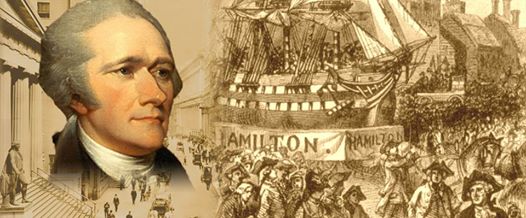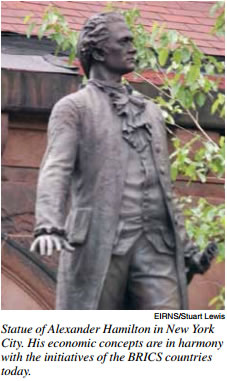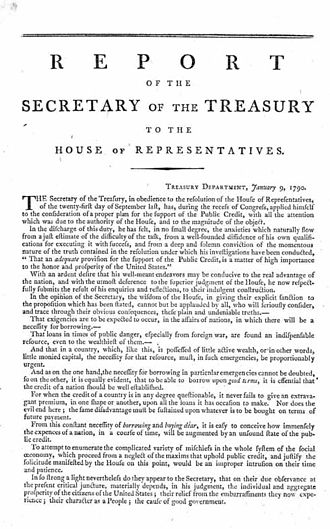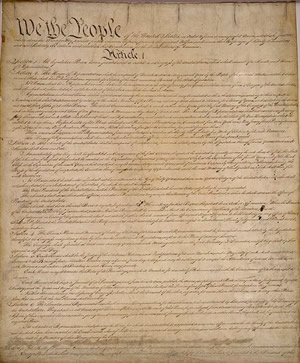This Week in History
January 4-10, 2015
A Vital Step for Cementing the Union
Alexander Hamilton's First Report on Public Credit
January 9, 1790
By Nancy Spannaus
On January 9, 1790, Treasury Secretary Alexander completed his "Report Relative to a Provision for the Support of Public Credit," the first of his four major reports establishing the principles of the American System of Economics. These reports were conceived as a totality, based on Hamilton's firm belief that the prosperity and survival of the newly formed United States required the establishment of a Federal (national) government with the powers to secure the objectives laid out in the Preamble to the Constitution, not only for the current population, but for its posterity. Those powers had to include control over the public credit of the nation, as indispensable to creating "a more perfect Union."

Bob Wesser
Left: Alexander Hamilton. Right: After New York ratified the Constitution in 1788, New York City celebrated with a parade. Hamilton, the Constitution's champion, was honored by a float representing the federal ship Hamilton. |
Hamilton's philosophical basis for his credit system, while not expressed in his public papers of the 1790s, derives from his adoption of a scientific outlook identifiable as that of German philosopher-scientist Gottfried Wilhelm Leibniz, himself a continuation of the Renaissance tradition of Nicholas of Cusa and Johannes Kepler--in contrast to the miserable social contract theories of John Locke, Isaac Newton, David Hume, and Thomas Hobbes. Hamilton asserted that Natural Law dictated that mankind dedicate himself to what Leibniz would have called the "science of happiness," and create a political system which brought people together to accomplish that end.
Indispensable to that system was unity around the goals of creating a prosperous, happy nation. The Report on Public Credit was based on the necessity of extending the political unity created with the adoption of the Constitution, to the unity of its finances, through the consolidation of the national debts incurred in the course of the War of Independence. If Hamilton and his allies had not won that battle, the nation could have quickly been lost.
The Battle for ‘Assumption’
 |
Specifically, Hamilton's report was based on how to deal with the massive debt crisis of the new nation--a burden of more than $50 million in debts (between principal and interest), much of it in arrears--in such as a way as to create the basis for economic growth and unity of the nation. His system required taking on, and subsuming, the sectarian and greedy interests of not only the speculators, but the state governments determined to maintain their independent power. Technically, the mechanism he demanded was assumption by the Federal government of all the debt incurred in the war, including those undertaken by the states. Under those conditions, the separate interests of the states would be intimately linked to that of the Federal government, itself an instrument for advancing the general welfare of the population.
From his earliest political life, accessible in his 1774 writings in support of the Continental Congress, Hamilton had waged principled and incisive attacks on sectionalism and faction as subversive to the nation's interests. His very first known writing, "A Full Vindication of the Measures of Congress," published in December 1774, takes on the attempts of the Tory advocate Samuel Seabury to pit the farmers against the merchants and artisans on the question of the non-importation agreement, as venal lies. In principle, he asserts, "In a civil society is the duty of each particular branch to promote not only the good of the whole community, but the good of every other particular branch."
The battle continued in Hamilton's leading role in the framing and adoption of the Constitution itself--including his stunning success in winning adoption in New York State, where he began with a majority of 46 to 19 against him, and won with a margin of 30 to 27.
|
Wikimedia Commons; public domain. |
Then, to the battle for Assumption in 1790. Hamilton's January 9 report is 20,000 words, and full of financial detail on how to support public credit. His most general summary, from the beginning, goes like this:
"To justify and preserve their confidence (friends of good government-ed); to promote the encreasing respectability of the American name; to answer the calls of justice; to restore landed property to its due value; to furnish new resources both to agriculture and commerce; to cement more closely the union of the states; to add to their security against foreign attack; to establish public order on the basis of an upright and liberal policy. These are the great and invaluable ends to be secured, by a proper and adequate provision, at the present period, for the support of public credit."
Hamilton goes on to argue that the consequences of such a policy will also be beneficial. To wit: it will likely allow public debt to serve the purposes of money; it will extend trade; it will promote agriculture and manufactures; it will lower the interest on money--and defeat those speculators, who, under the conditions of the time (not to mention now!), were profiting off the "fluctuation and insecurity" and turning U.S. debt into a "mere commodity."
Note that the metrics Hamilton identifies for his success, as reflections of the physical-economic growth of the economy, not monetarist measures for alleged financial health.
What followed was a specification of how his plan would help accomplish these aims--including the necessity for using the funded debt, which would basically be turned into annuities, as eventually used as the basis for the establishment of a National Bank. Hamilton specifically indicated that his second report would indicate how that would be done, as a means of turning the debt into credit for expanding agriculture and manufactures.
The Nation vs. the States
Hamilton's plan touched off a huge controversy, which lasted until the end of July 1790. By far, the most contentious aspect of the battle was the assumption of the state debts. Hamilton insisted that the nation was responsible as a whole for the debts it incurred in its creation, and thus should be responsible for dealing with them. But it had to "settle accounts" with the states. Each of the states was in a different financial situation vis-a-vis its creditors, some having paid them off, others with remaining huge liabilities, others having received aid from the Congress already, and all with powerful private financial interests (heavily speculators in public lands) weighing in on the question of how much taxation would result, what would be the value of their holdings, how much debt would be taken off their hands, etc. Virginia, home of the plantation system, was looking for the most advantageous position for itself, which included its desire to establish the Federal District on the Potomac.
Leading the resistance to assumption of the state debts was Hamilton's erstwhile close colleague, Congressman James Madison, but Virginian Madison--whose maneuverings had already given a huge boon to speculators in U.S. debt--was prepared to "deal," if he could get the capital on the Potomac.
Hamilton, who had no power in the Congress per se, but had tremendous influence with leading members, was known to be in favor of locating the Federal District in New York, but, to him, the location was secondary. What was important was the unity and survival of the nation--so he agreed, in a famous meeting with Jefferson and Madison in June, on working to get the votes for relocating the capital first out of New York City to Philadelphia, and then to the Potomac. Secondly, Hamilton agreed to trying to get the best deal for Virginia, in the accounting of state accounts vis-a-vis the Federal government.
|
First page of United States Constitution. |
At the conclusion of the negotiations, Hamilton had received Congressional approval for most of the policy he had presented: the settlement of state accounts; provisions for refinancing and serving the domestic debts and obtaining a new European loan to consolidate and refinance the foreign debt; establishing a Sinking Fund to manage the public debt; and an increase and revision of import duties to provide sufficient revenue for the Federal government, including servicing the interest on the debt. The stage was set for the next aspect of the program: the National Bank (December 1790), and then the fuller amplification of his concept of economic development in the Report on Manufactures (December 1791).
It was by means of the Bank, that Hamilton intended to ensure that the funded debt was used to build the nation, and national unity. It was in this context that his famous maxim from the Report Relative to Public Credit should be read:
"Persuaded as the Secretary is, that the proper funding of the present debt, will render it a national blessing: Yet he is so far from acceding to the position, in the latitude in which it is sometimes laid down, that `public debts are public benefits,' a position inviting to prodigality, and liable to dangerous abuse,--that he ardently wishes to see it incorporated, as a fundamental maxim, in the system of public credit of the United States, that the creation of debt should always be accompanied with the means of its extinguishment. This he regards as the true secret for rendering public credit immortal. And he presume, that it is difficult to conceive a situation, in which there may not be an adherence to the maxim. At least he feels an unfeigned solicitude, that this may be attempted by the United States, and that they may commence their measures for the establishment of credit, with the observance of it."
For further reading:
In addition to reading Hamilton's full report[1], readers are referred to Forrest McDonald, "Alexander Hamilton, A Biography," WW Norton & Company, New York, 1979, and the listing of important articles below.
[1] Read the full text (two documents):
http://schillerinstitute.org/economy/2015/hamilton-first_report_on_the_public_credit.pdf,
http://schillerinstitute.org/economy/2015/hamilton-Final_Version_2nd_Report_Public_Credit.pdf


